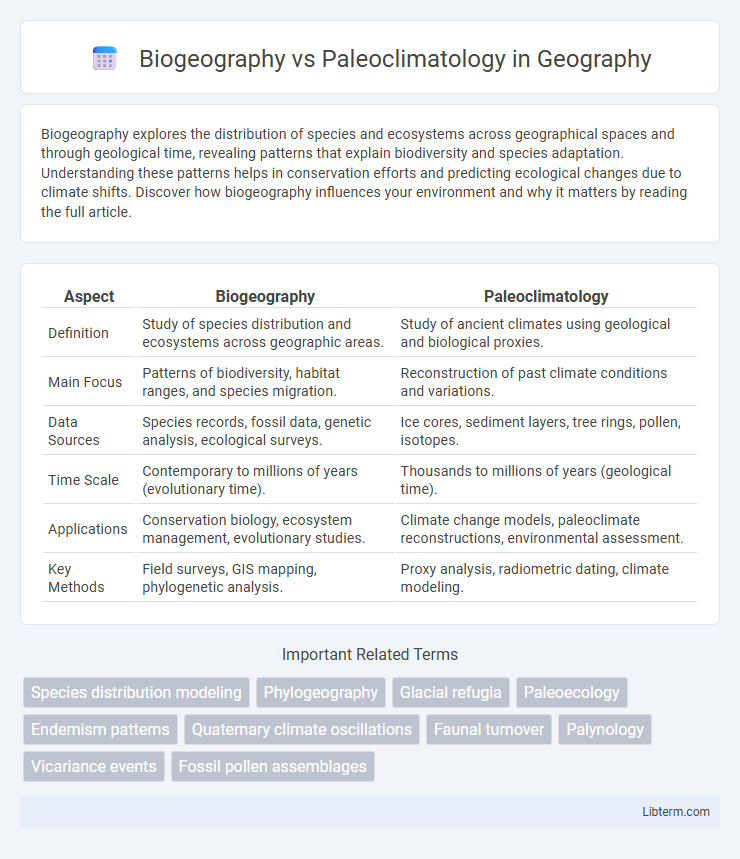Biogeography explores the distribution of species and ecosystems across geographical spaces and through geological time, revealing patterns that explain biodiversity and species adaptation. Understanding these patterns helps in conservation efforts and predicting ecological changes due to climate shifts. Discover how biogeography influences your environment and why it matters by reading the full article.
Table of Comparison
| Aspect | Biogeography | Paleoclimatology |
|---|---|---|
| Definition | Study of species distribution and ecosystems across geographic areas. | Study of ancient climates using geological and biological proxies. |
| Main Focus | Patterns of biodiversity, habitat ranges, and species migration. | Reconstruction of past climate conditions and variations. |
| Data Sources | Species records, fossil data, genetic analysis, ecological surveys. | Ice cores, sediment layers, tree rings, pollen, isotopes. |
| Time Scale | Contemporary to millions of years (evolutionary time). | Thousands to millions of years (geological time). |
| Applications | Conservation biology, ecosystem management, evolutionary studies. | Climate change models, paleoclimate reconstructions, environmental assessment. |
| Key Methods | Field surveys, GIS mapping, phylogenetic analysis. | Proxy analysis, radiometric dating, climate modeling. |
Introduction to Biogeography and Paleoclimatology
Biogeography examines the spatial distribution of living organisms across different geographical regions, analyzing patterns influenced by ecological and evolutionary processes. Paleoclimatology studies Earth's past climates by interpreting data from ice cores, sediment layers, and fossil records to understand climate changes over geological time. Integrating biogeographical data with paleoclimatic reconstructions provides insights into how ancient climate shifts impacted species distribution and ecosystem dynamics.
Defining Biogeography: Scope and Importance
Biogeography examines the distribution of species and ecosystems across geographic space and through geological time, providing critical insights into patterns of biodiversity and the factors shaping them. It integrates ecological, evolutionary, and geological perspectives to understand species dispersal, habitat preferences, and the impact of environmental changes. This field is essential for conservation planning, predicting responses to climate change, and managing natural resources effectively.
What is Paleoclimatology? Key Concepts
Paleoclimatology is the scientific study of past climates using natural records such as ice cores, tree rings, and sediment layers to reconstruct temperature, precipitation, and atmospheric composition over geological time. Key concepts include proxy data analysis, which involves interpreting indirect evidence to understand historical climate conditions, and the study of climate variability and change throughout Earth's history. Understanding paleoclimatology provides essential context for current climate models and predictions by revealing long-term climate patterns and natural climate drivers.
Methods and Tools in Biogeography
Biogeography employs Geographic Information Systems (GIS), remote sensing, and species distribution modeling to analyze spatial patterns of biodiversity across various scales. Molecular techniques such as DNA barcoding and phylogenetic analysis facilitate the understanding of evolutionary relationships and species dispersal. Field surveys and ecological niche modeling help map habitat preferences and predict potential range shifts in response to environmental changes.
Techniques Used in Paleoclimatology
Paleoclimatology employs techniques such as ice core analysis, dendrochronology, and sediment core sampling to reconstruct past climate conditions with high precision. Stable isotope analysis and radiometric dating further enhance the resolution of paleoclimatic data, enabling accurate timelines of climate change. These methods provide critical insights into Earth's historical climate variability, complementing biogeographical studies by contextualizing species distribution shifts over geological timescales.
Comparative Analysis: Biogeography vs Paleoclimatology
Biogeography examines the distribution of species and ecosystems across geographical spaces and through geological time, emphasizing patterns shaped by factors such as plate tectonics, climate change, and habitat fragmentation. Paleoclimatology focuses on reconstructing past climate conditions using proxies like ice cores, tree rings, and sediment records to understand earth's climatic history and its impact on life. Comparative analysis reveals biogeography's strength in interpreting biological patterns influenced by historical climates, while paleoclimatology provides the climatic context essential for explaining those biological changes over geological epochs.
Interdisciplinary Connections between the Two Fields
Biogeography and paleoclimatology intersect through the study of historical climate patterns and their influence on species distribution and ecosystem changes over geological time scales. Advances in paleoclimatology provide critical climate reconstructions that inform biogeographers about habitat shifts, migration routes, and biodiversity responses to past climate events. This interdisciplinary synergy enhances understanding of evolutionary processes and aids in predicting future ecological dynamics amid climate change.
Case Studies: Insights from Biogeography and Paleoclimatology
Case studies integrating biogeography and paleoclimatology reveal distinct patterns of species distribution shifts in response to historical climate changes, such as glacial cycles impacting North American flora. Analysis of fossil pollen records combined with biogeographic mapping illustrates how past climate fluctuations influenced habitat ranges and biodiversity hotspots. These interdisciplinary insights enhance understanding of current species resilience and inform predictive models of ecological response to future climate scenarios.
Applications in Modern Research and Environmental Science
Biogeography offers critical insights into species distribution patterns and ecosystem dynamics, aiding conservation efforts and predicting biodiversity responses to climate change. Paleoclimatology provides essential climate data from geological records, informing models on past atmospheric conditions that help forecast future climate trends. Integrating biogeographical data with paleoclimatic evidence enhances the understanding of historical biodiversity shifts, improving strategies for environmental management and habitat restoration.
Future Trends in Biogeography and Paleoclimatology
Advancements in remote sensing and climate modeling are driving future trends in biogeography and paleoclimatology, enabling more precise mapping of species distributions and past climate patterns. Integration of genomic data with paleoclimate reconstructions is enhancing predictions of ecosystem responses to future climate change. Emerging machine learning algorithms are transforming data analysis, allowing for improved forecasting of biodiversity shifts and climatic conditions over geological timescales.
Biogeography Infographic

 libterm.com
libterm.com